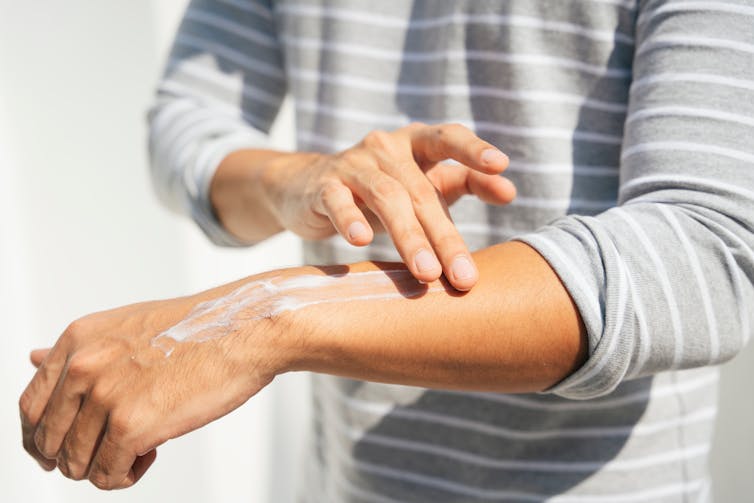
Cosmetics and personal care products enhance the way we look and feel. During the pandemic, I started a self-care facial routine. It helped me cope with lockdown orders, while simultaneously adjusting to my new identity as a mom. I applied toner, serum and cream to brighten mornings and relax evenings.
But many of these products contain chemicals called per- and polyfluoroalkyl substances (PFAS), also known as ‘forever chemicals.’ They are used as ingredients that can make products waterproof, long-lasting and help them spread smoothly across skin.
European data indicates there are about 170 PFAS ingredients for use in cosmetics and personal care products. Each year, upwards of 80,000 kg of PFAS may be released after product use to wastewater and solid waste streams, a significant source of PFAS to the environment.

Persistent contaminants
PFAS are persistent environmental contaminants. The properties that make them commercially useful, particularly their stability, also means that there is no environmental mechanism to degrade them, and so they accumulate. PFAS have been found across the globe, including remote regions like the Arctic.
PFAS also accumulate in the body. The Canadian Health Measures survey sampled blood from thousands of people and found several PFAS in all participants.
Major sources of PFAS exposure to people are through diet, from drinking contaminated water or ingesting food, such as fish or meat. Agricultural fields can contain PFAS from biosolids used as fertilizer, as wastewater treatment plants cannot remove them.
Therefore, PFAS are transported via biosolids to crops and animals. Similarly, PFAS are added to personal care products, applied, then washed off to enter wastewater treatment plants, contributing to a global environmental problem.
PFAS in personal care products
In our study, we measured PFAS in cosmetics and personal care products purchased in Canada. Products included bronzers, concealers, foundations, shaving creams, sunscreens and moisturizers.
PFAS were extracted from each product and measured using mass spectrometry instrumentation. These instruments identify individual PFAS present in the products, at high milligram amounts or down to a trillionth of a gram.
Particularly high levels stemmed from products containing the following ingredients: C6-16 perfluoroalkyl ethyl phosphates, perfluorooctyl triethoxysilane, and perfluorobutyl ethers. The Canadian government has prohibited some PFAS from products, including perfluorooctanoic acid (PFOA), and any chemical that degrades to produce PFOA.
New proposed Canadian PFAS regulations will set a threshold level at one microgram per gram in products. This means that PFAS at or below this level would be incidental and the prohibition would not apply. Yet we found that some products contained PFAS — including those prohibited from use — at levels a thousand times higher than the incidental level — pointing towards a lack of oversight when it comes to managing PFAS in the personal care product industry.
Higher PFAS levels
Epidemiological studies are showing that PFAS levels in the body are related to regular use of cosmetic and personal care products. One study in the United States noted higher blood levels of PFAS in women that typically wore foundation. A study from Korea linked application of cosmetics and personal care products to higher PFAS levels in breast milk.
Another study illustrated this trend more directly. PFOA was purposefully added to a sunscreen to determine whether blood levels in one person would increase after application. Within three weeks, the PFOA from the sunscreen application equalled about 10 per cent of the total amount of PFOA in his body. This suggests that the daily application of a PFAS-containing sunscreen during summer months — and frequent application of other PFAS-containing cosmetics and personal care products — would result in high blood levels.

Unlike other chemicals, certain PFAS like PFOA are persistent. This means that human exposure to even low amounts of PFAS can accumulate over time. The half-life of PFOA in humans is about two years.
Even after this point, half the amount of PFOA remains and it takes even more years for it to be eliminated. However, continuous exposure from multiple sources, including the use of cosmetics and personal care products, guarantee that PFOA and similar PFAS, are never eliminated.
Health implications
In Canada, the PFAS frequently measured in the environment with adverse health implications are prohibited from use. These include PFOA and PFOS, long-chain PFCAs, and any compound that degrades to produce them. This is a broader regulatory approach compared to other regions, including the U.S., which restricts individual PFAS.
But other regions are taking an even broader approach. The European Union’s proposed ban would eliminate thousands of PFAS. California is planning to effectively eliminate any PFAS ingredient used in cosmetics and apparel by 2025.
Canada should consider a similar approach, as a solution to protect people from exposure to these chemicals when applying cosmetics and personal care products, and eliminate their transfer to the environment after use.

Regulation and information
There is a solution: ban PFAS from cosmetics and personal care products. Some cosmetic retailers like Sephora do not include PFAS on their “clean” cosmetic lists so that consumers can avoid their use. But PFAS-containing cosmetics and personal care products are still readily available to Canadians.
PFAS are absent from the Canadian Cosmetic Ingredient Hotlist, the list that contains ingredients prohibited from use in cosmetics and personal care products sold in Canada.
Environmental groups, managers, and industry should work together to stop using PFAS in cosmetics and personal care products, and instead use other ingredients that serve the same purpose.
At the very least, people should be aware of the PFAS in these products through clear labelling so that they can make informed decisions. Since completing this study, I have screened the ingredients in my products, only to find that a couple contained PFAS. I switched to other products.![]()
Amy Rand, Assistant professor, Environmental Chemistry and Toxicology, Carleton University
This article is republished from The Conversation under a Creative Commons license. Read the original article.

